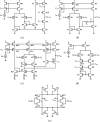Recent advances in neural recording microsystems
- PMID: 22163863
- PMCID: PMC3231370
- DOI: 10.3390/s110504572
Recent advances in neural recording microsystems
Abstract
The accelerating pace of research in neuroscience has created a considerable demand for neural interfacing microsystems capable of monitoring the activity of large groups of neurons. These emerging tools have revealed a tremendous potential for the advancement of knowledge in brain research and for the development of useful clinical applications. They can extract the relevant control signals directly from the brain enabling individuals with severe disabilities to communicate their intentions to other devices, like computers or various prostheses. Such microsystems are self-contained devices composed of a neural probe attached with an integrated circuit for extracting neural signals from multiple channels, and transferring the data outside the body. The greatest challenge facing development of such emerging devices into viable clinical systems involves addressing their small form factor and low-power consumption constraints, while providing superior resolution. In this paper, we survey the recent progress in the design and the implementation of multi-channel neural recording Microsystems, with particular emphasis on the design of recording and telemetry electronics. An overview of the numerous neural signal modalities is given and the existing microsystem topologies are covered. We present energy-efficient sensory circuits to retrieve weak signals from neural probes and we compare them. We cover data management and smart power scheduling approaches, and we review advances in low-power telemetry. Finally, we conclude by summarizing the remaining challenges and by highlighting the emerging trends in the field.
Keywords: brain-computer interfaces; data management; implantable microsystems; inductive link; low-power biotelemetry; multi-channel; neural recording; power scheduling; sensory circuits; ultrawide-band.
Figures






Similar articles
-
Approaches for the efficient extraction and processing of biopotentials in implantable neural interfacing microsystems.Annu Int Conf IEEE Eng Med Biol Soc. 2011;2011:5855-9. doi: 10.1109/IEMBS.2011.6091448. Annu Int Conf IEEE Eng Med Biol Soc. 2011. PMID: 22255671 Review.
-
Wireless gigabit data telemetry for large-scale neural recording.IEEE J Biomed Health Inform. 2015 May;19(3):949-57. doi: 10.1109/JBHI.2015.2416202. Epub 2015 Mar 24. IEEE J Biomed Health Inform. 2015. PMID: 25823050
-
Micropower circuits for bidirectional wireless telemetry in neural recording applications.IEEE Trans Biomed Eng. 2005 Nov;52(11):1950-9. doi: 10.1109/TBME.2005.856247. IEEE Trans Biomed Eng. 2005. PMID: 16285399
-
Implementation of multichannel sensors for remote biomedical measurements in a microsystems format.IEEE Trans Biomed Eng. 2004 Mar;51(3):525-35. doi: 10.1109/TBME.2003.820370. IEEE Trans Biomed Eng. 2004. PMID: 15000383
-
Multi-Channel Neural Recording Implants: A Review.Sensors (Basel). 2020 Feb 7;20(3):904. doi: 10.3390/s20030904. Sensors (Basel). 2020. PMID: 32046233 Free PMC article. Review.
Cited by
-
A CMOS IC-based multisite measuring system for stimulation and recording in neural preparations in vitro.Front Neuroeng. 2014 Oct 10;7:39. doi: 10.3389/fneng.2014.00039. eCollection 2014. Front Neuroeng. 2014. PMID: 25346683 Free PMC article.
-
Developing Precision Invasive Neuromodulation for Psychiatry.J Neuropsychiatry Clin Neurosci. 2021 Summer;33(3):201-209. doi: 10.1176/appi.neuropsych.20100268. Epub 2021 May 14. J Neuropsychiatry Clin Neurosci. 2021. PMID: 33985346 Free PMC article.
-
A Low Noise Amplifier for Neural Spike Recording Interfaces.Sensors (Basel). 2015 Sep 30;15(10):25313-35. doi: 10.3390/s151025313. Sensors (Basel). 2015. PMID: 26437411 Free PMC article.
-
Recent Advancements in Graphene-Based Implantable Electrodes for Neural Recording/Stimulation.Sensors (Basel). 2023 Dec 18;23(24):9911. doi: 10.3390/s23249911. Sensors (Basel). 2023. PMID: 38139756 Free PMC article. Review.
-
A wideband dual-antenna receiver for wireless recording from animals behaving in large arenas.IEEE Trans Biomed Eng. 2013 Jul;60(7):1993-2004. doi: 10.1109/TBME.2013.2247603. Epub 2013 Feb 15. IEEE Trans Biomed Eng. 2013. PMID: 23428612 Free PMC article.
References
Publication types
MeSH terms
LinkOut - more resources
Full Text Sources
Other Literature Sources

